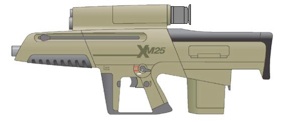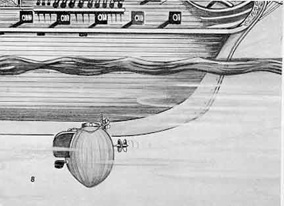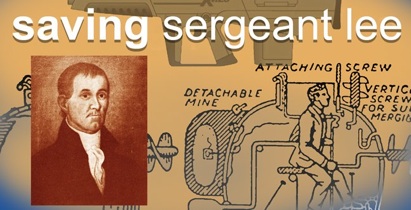saving sergeant lee
American Revolution & Innovation
by Eric B. Ramey
Sergeant Lee grips the controls with determination as he works his way into a position to strike at the enemy.

234 years later…
In the rugged terrain of Afghanistan, the United States has “rolled out” a revolutionary new weapon, capable of killing an enemy behind cover. The XM-25 Individual Airburst Weapon System is a new twist on the old concept of the rocket propelled grenade. It uses “smart” grenades that actually communicate with the gun. When fired, these grenades travel to the target, gauge the distance using the launcher’s built-in laser, and explode two feet above and behind an entrenched enemy, effectively eliminating the advantage of cover.

When the United States was striving for nationhood, she got help from revolutionary individuals who were willing to bring new ideas, and new weapons, into the fight. David Bushnell was one of these individuals, a man who took an idea, developed a design, built a machine, and became the father of submarine warfare.
Bushnell was born and raised in colonial Connecticut. The son of a Saybrook farmer, he attended Yale University at the rather advanced age of 31. During his time as a student, Bushnell became interested in the concept of exploding gunpowder underwater. Despite academia’s position that this was an impossibility, Bushnell set out to prove it could be done. Not only did he prove his theory, he showed that the water’s density made the gunpowder even more destructive when submerged.

In 1775, Bushnell graduated into a world set upon by revolution and revolutionary ideas. Determined to lend their talents to the cause of Independence, Bushnell and his brother Ezra offered the Continental forces a one-man submarine they had constructed. The sub had been designed to place a keg full of gunpowder against the hull of an unsuspecting British warship. Because the little vessel looked like two turtle shells strapped together, Bushnell christened her the “Turtle.” Measuring roughly 6 feet high and 7 feet long, the Turtle was the technological wonder of its day. From the propeller, to the pumps, to the clockwork time-delay device in the gunpowder laden keg, most everything in and on the submarine was new, innovative, and temperamental. However, the real innovation lay in the bomb around which she was designed. The submarine was only the delivery system for Bushnell’s underwater mine. Designed with a time-delay clockwork device to trigger a modified flintlock, the bomb was set to explode after the operator of the submarine had screwed it into the underside of an enemy warship and made his escape.
Like today’s XM-25 grenade launcher, the Turtle was not a new idea, but a new twist on an old idea. Both weapons, it seems, can trace their genesis to the 16th Century. In fact, it is very probable that Bushnell based his vessel on an earlier submarine constructed and tested in the 1690’s by Denis Papin, a member of the British Royal Society. In doing so he demonstrated the uniquely American trait of taking existing technology and improving on it.















